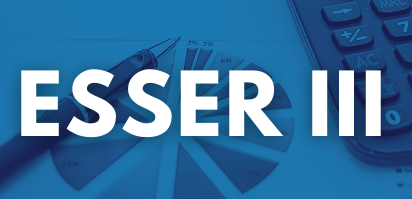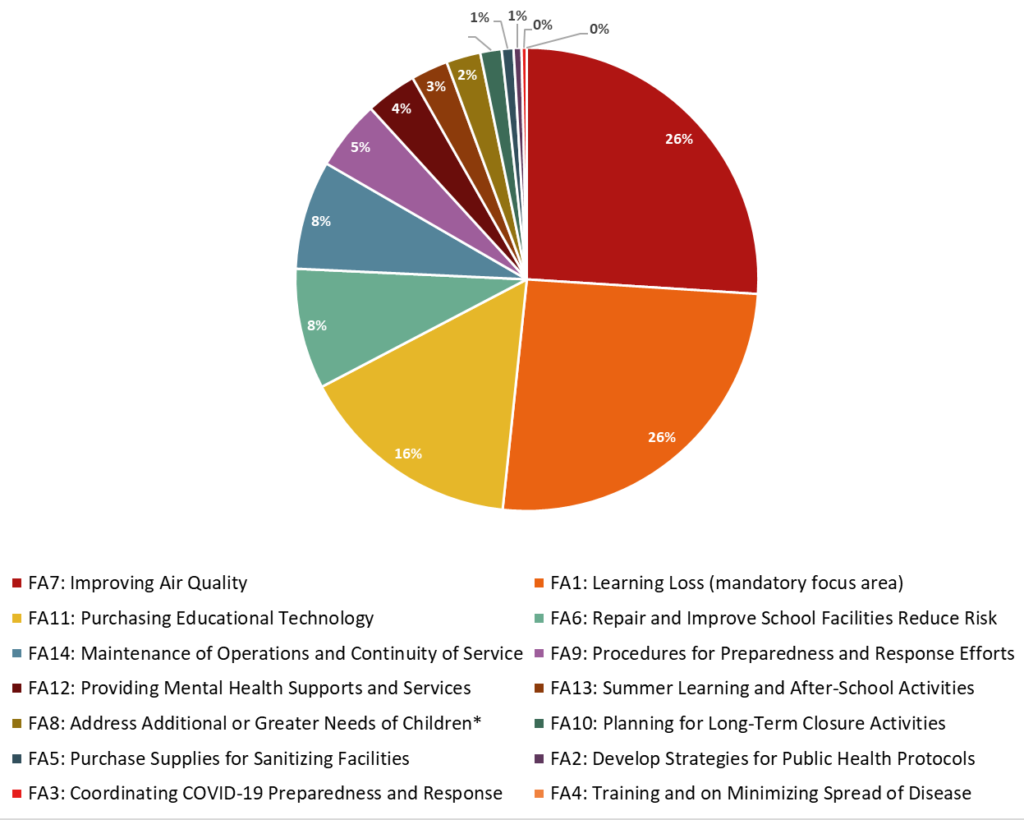How Will Delaware Schools Spend Federal Stimulus Funds? A Breakdown
– Delaware received $411 million for K-12 education as part of President Joe Biden’s $1.9 trillion American Rescue Plan Act.
-Local schools and districts submitted formal plans detailing how they will use these funds.
-Some key themes have emerged from those plans, including: addressing learning loss, educational technology, mental health services, and serving low-income families, children with disabilities, English learners, racial and ethnic minorities, and more.

President Joe Biden’s $1.9 trillion American Rescue Plan Act, the third federal stimulus package since the onset of the COVID-19 pandemic, provides $350 billion for states, local governments, territories and tribal governments, with around $125 billion nationally earmarked for K-12 schools through the Elementary and Secondary School Emergency Relief (ESSER) funding stream.
Out of the $125 billion dollars in the ESSER III pot, Delaware received approximately $411 million. As written in the federal law, 10 percent of Delaware’s funding went to the state Department of Education (DDOE), and the remaining 90 percent went directly to Local Education Agencies (LEAs), otherwise known as districts and charter schools.
In order to receive the full amount of funding under ESSER III, both the DDOE and LEAs are required to submit plans detailing how they will use these funds (which in turn were required to be posted publicly). DDOE’s plan was submitted in June and recently approved by the U.S. Department of Education.
As of this week, all of the district and charter school plans have been posted on DDOE’s website.
We looked at all of the 42 plans to understand how LEAs in Delaware plan to use their funding.
Update (2/16/22): Check out this latest analysis from FutureEd @ Georgetown University, which breaks down local spending by district poverty level, among many other revealing highlights.
Guidelines for LEAs
- Funding was distributed to LEAs based on Title I.
- LEAs were required to use 20 percent of their funding to address the academic impact of learning loss on their students. All plans meet and, in some cases, exceed that minimum. Other than that, the guidelines were focused on the impact of the pandemic on students and schools.
- As outlined in the state’s ESSER plan, at a minimum, LEA plans had to describe the following:
- How funds will be used to implement COVID-19 prevention and mitigation strategies
- How LEAs will use the mandatory set-aside for learning loss and other allowable uses
- How the LEA will ensure that the ESSER funded interventions will respond to the needs of all students, and particularly students disproportionately impacted by COVID-19
- The plans vary, with some providing detailed information for each initiative and use of funding and other plans offering general or minimal detail.
- The plans are district-level and charter school-level—there are no individual school-based plans within districts available on the Delaware Department of Education’s website.
Learning Loss, Technology, Lead Areas of Focus
Districts and charters had to identify on which areas out of 14 provided in the grant they plan to focus their portion of ESSER III funds. Out of the 14 areas, the five most commonly identified include:
- Addressing Learning Loss
- Purchasing Educational Technology
- Providing Mental Health Services and Supports
- Other Activities for Maintenance of Operations and Continuity of Service
- Supports for Students with Additional and/or Greater Needs
*This includes children from low-income families, children with disabilities, English learners, racial and ethnic minorities, students experiencing homelessness, and foster care youth. **Percent is out of the total number of LEAs (which is 42) Source: Delaware Department of Education (2021). District, charter spending plans. Retrieved from: https://www.doe.k12.de.us/Page/4458 When looking at the money allocated to the focus areas identified by districts only, repairing facilities and improving air quality emerges as a major theme—and a major price tag. While more districts identified purchasing education technology over improving air quality as a focus area, improving area quality carries a much higher allotment of money. *This includes children from low-income families, children with disabilities, English learners, racial and ethnic minorities, students experiencing homelessness, and foster care youth. Note: This chart does not include charter school focus areas or allocations. Some districts included portions of their ESSER II funding in their budget allocations in their ESSER III plans. Source: Delaware Department of Education (2021). District, charter spending plans. Retrieved from: https://www.doe.k12.de.us/Page/4458 Further, the chart below shows the approximate percentage breakdown of where districts are allocating their ESSER III money by focus area. As shown below, a little over three quarters of the funding is allocated to the following areas: *This includes children from low-income families, children with disabilities, English learners, racial and ethnic minorities, students experiencing homelessness, and foster care youth. Note: This chart does not include charter school focus areas or allocations. Some districts included portions of their ESSER II funding in their budget allocations in their ESSER III plans. Source: Delaware Department of Education (2021). District, charter spending plans. Retrieved from: https://www.doe.k12.de.us/Page/4458 Hiring Staff, Mental Health, and Extra Learning Opportunities, A Major Focus LEAs were also required to answer more targeted questions about the general plan and use of ESSER III funds. Combined with the focus areas, six areas were most commonly identified. Trends across all districts and charters are clear within this required bucket of spending. Many schools are relying on evidence-based practices for accelerated learning to address learning loss brought on by the pandemic. All schools mentioned versions of the following: Overwhelmingly, schools are using additional ESSER III funds for technology. Many LEAs pointed to the importance of a 1:1 device-to-student ratio but others included training for educators, hiring a technology consultant or supervisor, licenses for digital learning tools, and updating infrastructures such as broadband and Wi-Fi. The majority of plans (around 30) mentioned hiring new staff for positions like interventionists, counselors, psychologists, special education teachers, paraprofessionals, and others. Plans also mentioned addressing substitute needs, transportation needs, and indirect costs. Others pointed to utilizing screeners for mental health and socioemotional needs, working to provide workshops and enhance communication with families, and partnering with outside organizations. Stay tuned to the Rodel blog for more updates as they come. Related Topics: american rescue plan act, Delaware education, delaware school funding, delaware schools, elementary and secondary school emergency relief, esser, federal stimulus
Focus Area (FA)
Approximate Number of LEAs
Percent**
FA1: Learning Loss (mandatory focus area)
42
100%
FA11: Purchasing Educational Technology
29
69%
FA14: Maintenance of Operations and Continuity of Service
27
64%
FA12: Providing Mental Health Supports and Services
24
57%
FA8: Address Additional or Greater Needs of Children*
22
52%
FA13: Summer Learning and After-School Activities
20
48%
FA6: Repair and Improve School Facilities Reduce Risk
19
45%
FA7: Improving Air Quality
19
45%
FA5: Purchase Supplies for Sanitizing Facilities
15
36%
FA2: Develop Strategies for Public Health Protocols
10
24%
FA10: Planning for Long-Term Closure Activities
8
19%
FA3: Coordinating COVID-19 Preparedness and Response
7
17%
FA9: Procedures for Preparedness and Response Efforts
6
14%
FA4: Training and on Minimizing Spread of Disease
1
2%
Note: “LEAs” include districts and charter schools. Numbers are approximate based on analysis of plans.
Focus Area
Range
Approximate Number of Districts That
Prioritized This
Focus Area
FA1: Learning Loss (mandatory focus area)
$75M-100M
19
FA7: Improving Air Quality
$75M-100M
14
FA11: Purchasing Educational Technology
$50M-75M
16
FA14: Maintenance of Operations and Continuity of Service
$25M-50M
15
FA6: Repair and Improve School Facilities Reduce Risk
$25M-50M
13
FA8: Address Additional or Greater Needs of Children*
$1M-25M
12
FA12: Providing Mental Health Supports and Services
$1M-25M
12
FA13: Summer Learning and After-School Activities
$1M-25M
12
FA5: Purchase Supplies for Sanitizing Facilities
$1M-25M
11
FA2: Develop Strategies for Public Health Protocols
$1M-25M
6
FA10: Planning for Long-Term Closure Activities
$1M-25M
6
FA3: Coordinating COVID-19 Preparedness and Response
$1M-25M
5
FA9: Procedures for Preparedness and Response Efforts
$1M-25M
4
FA4: Training and on Minimizing Spread of Disease
$1M-25M
1
